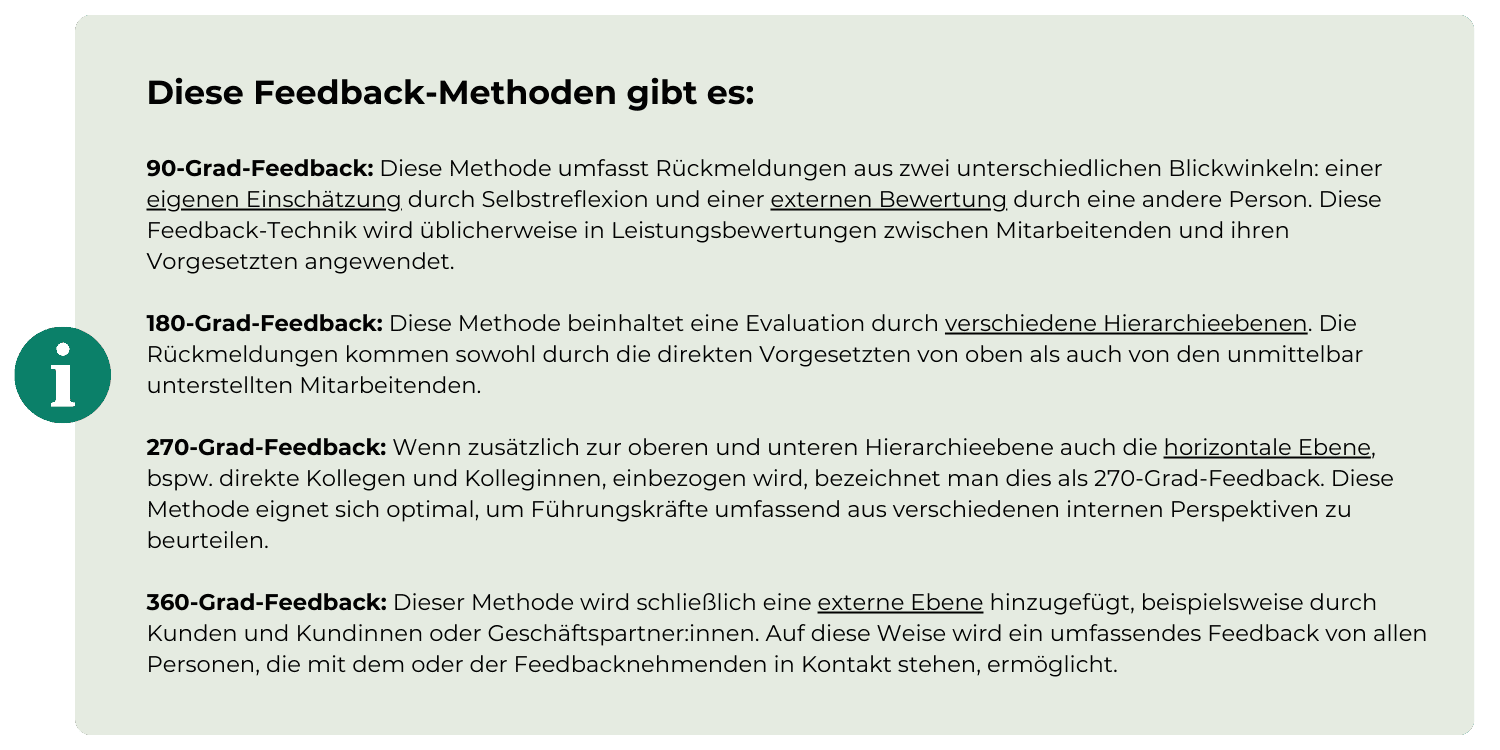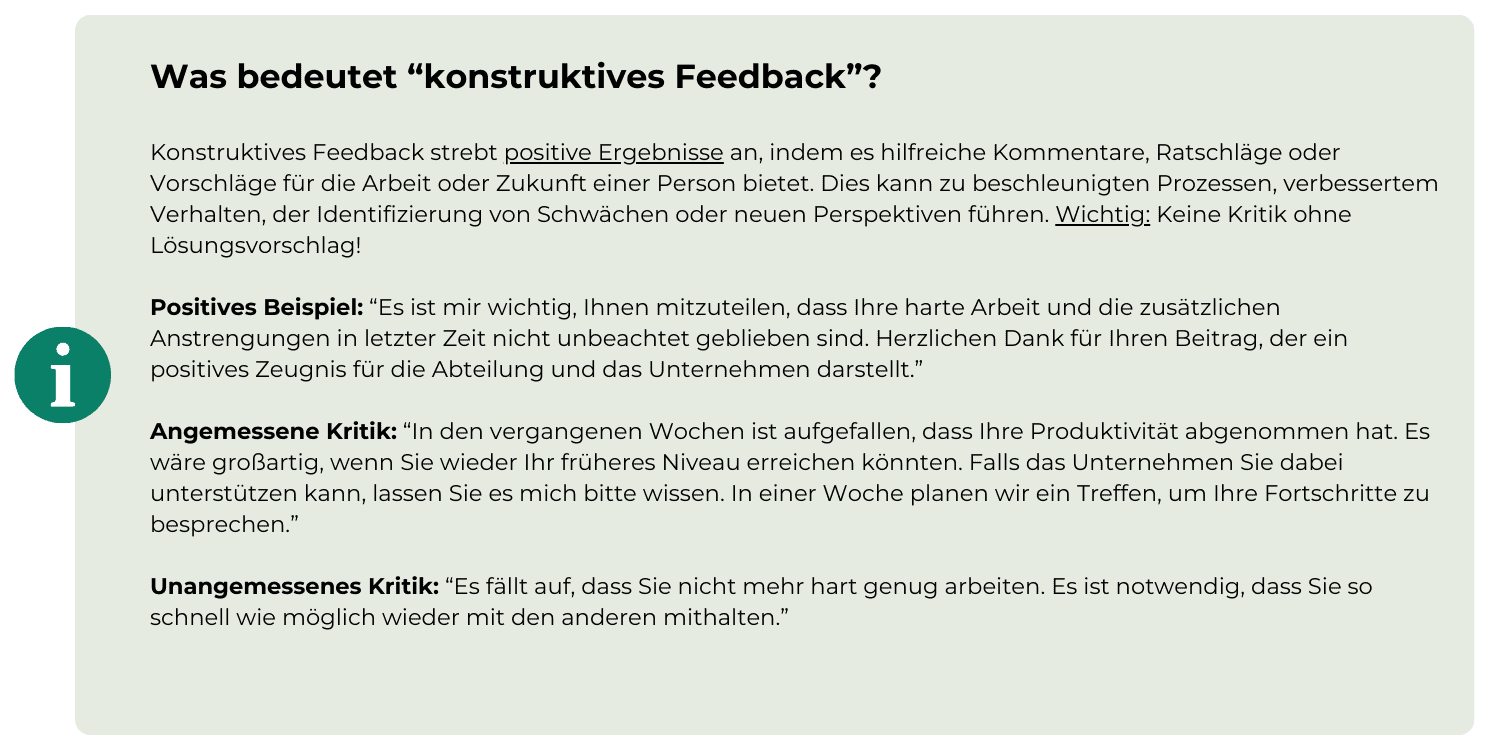
A constructive feedback culture is crucial for the continuous improvement of your team and the promotion of individual and organisational performance. Open feedback provides you and your team members with valuable insights that help them to expand their skills and optimise their performance. However, establishing such a feedback culture can be a challenging task in many organisations. This process can be particularly complex when the goal is to ensure continuous performance management and evaluation of everyone in the organisation. In today's blog article, we would like to explain why a well-established feedback culture is so important and how you can successfully implement it in your organisation.
Nobody is error-free, neither you, your team members nor your superiors. Mistakes are human, but what counts is the ability to learn from them and continuously improve. Effective and constructive feedback plays a crucial role in this. But the benefits of a strong feedback culture go far beyond individual learning processes. These are the benefits you benefit from the most:
Probably the most significant advantage of an open feedback culture lies in the associated cost savings. How? Numerous studies have shown that companies that integrate regular (employee) feedback achieve a significant cost reduction. Almost 15 per cent lower fluctuation rate than their competitors. This is crucial, as staff turnover represents a significant financial cost. Employees who do not feel valued tend to leave the company. Especially Among millennials, this proportion is an impressive 76 per cent! According to a survey by Globoforce and SHRM, continuous peer feedback and regular check-ins have a positive impact on organisations, such as 89 per cent of the HR managers surveyed confirmed. These findings show that employees who receive feedback and feel valued are more satisfied and stay with the company longer. A low turnover rate not only means a more stable team structure for your company, but also considerable cost savings, as the recruitment effort and costs for new hires are minimised. Considering that each dismissal your company up to one third of the employee's annual salary The financial impact of a stable feedback culture can be significant.
When you give feedback, your aim should not be to belittle someone or criticise them in a rude way. Instead, the focus is on praising good performance or constructively pointing out how someone can develop further. In an effective feedback culture, your employees are continually encouraged to reflect on the way they work. This incentivises individual learning, personal improvement and professional development. This approach promotes sogrowth orientation - a concept introduced by psychology professor Carol Dweck at Stanford University. The basic idea is that people with a growth-oriented attitude do not see mistakes as a humiliating failure, but as an exciting opportunity for learning and personal development. A consistently implemented promotion of the feedback culture therefore means that your employees do not perceive feedback as negative, but rather as an opportunity for personal development. This in turn can help to improve individual performance and promote the growth of your organisation.
In a professional environment, nothing is more damaging than a lack of open and honest communication. Your employees should always feel that they can express their opinions or raise concerns without fear of negative consequences. A lack of this openness creates a corporate culture characterised by secrecy, dishonesty and suppressed emotions. This not only affects the morale and performance of your team, but also reduces the attractiveness of the workplace. A toxic working environment can damage your company in the long term! Building a constructive feedback culture, on the other hand, promotes an atmosphere of open and honest communication in which employees feel encouraged to express their thoughts freely - without restraint, but constructively! This helps to create transparency and enables healthier and more beneficial collaboration within your team.
Encouraging open communication has a direct impact on interpersonal relationships in the workplace. If your team recognises that openness and honest feedback are actively supported and exemplified, they will be more inclined to express their opinions freely. This positive dynamic not only influences the way they work, but also extends to the quality of interpersonal relationships. A well-established feedback culture creates an environment in which your team members always feel comfortable. After all, when everyone feels comfortable in their own skin and can be themselves, the result is more authentic, trusting and positive relationships. more personal professional relationships.
Imagine how extensive the insights could be if all employees were constantly thinking about how to improve their performance and optimise the way they work, and sharing this openly. In traditional organisations, feedback is usually only gathered once or twice a year as part of performance appraisals / performance reviews. However, these appraisals only offer limited opportunities for discussion and there is also a risk that events are forgotten between meetings. A daily feedback culture allows your team to gather much more information throughout the year than just at specific, set times.
Now that we've learnt about the importance of feedback in the workplace and the benefits of an open feedback culture, you're probably wondering: how can I actually implement this in my company? Well, the following 10 steps can help you to implement a successful feedback culture at eye level. Benefit from the following measures:
It is easier to develop a new practice from the outset than to change an existing one - especially with new team members who have just joined your organisation. When a new team member joins your organisation, they will find themselves in a new working environment with its own processes, customs and forms of communication. Even if this person brings certain work preferences with them, adaptation is inevitable. Communicating the specific working methods of your company during the onboarding process is crucial. Guidelines shared early on, such as your own meeting guidelines, allow new employees to settle in more quickly and internalise your company culture. The same principle applies to introducing your feedback culture. The sooner you show new team members that your organisation values open and honest feedback, the more likely they are to integrate this practice into their daily work. The prerequisite for success here is that your existing team has already internalised and lives out the desired feedback culture.
Imagining a great feedback culture alone is not enough; unless your team members recognise the value of feedback or know how to give it effectively, such a culture will not be successful. Therefore, it is crucial to conduct feedback training for all team members in order to establish a robust feedback culture. This can take the form of company-wide presentations, team workshops or simply introducing and internalising your feedback guidelines and rules. Show your team the importance of such a culture and explain different types of feedback (and when they are appropriate). Also explain the appropriate approach to giving and receiving feedback and set clear expectations in line with organisational standards. Example: Never give negative feedback without offering possible solutions or suggestions for improvement.

Not only is it important to communicate the importance of feedback to your team members, but also to create an environment where they actually feel comfortable giving or receiving feedback. People are often nervous when it comes to feedback. After all, it could mean that you have done something wrong, the other person will take the feedback badly and this could be associated with negative consequences, perhaps even losing your job. But: This should not be the perspective on feedback! Nobody is perfect and feedback should rather be used to help people grow and improve. When someone gives feedback, it is not because they think the recipient should be sacked. Rather, it is an incentive to optimise work. It is the responsibility of the organisation to break the stigma around feedback and create a safe environment for employees to share! This requires clear communication of your organisation's anti-retaliation policy! You should explain that feedback is aimed at improving work. Your employees should understand that there are no negative consequences for giving constructive criticism. Once your employees realise this, the feedback culture in your company will quickly flourish.
Even if your colleagues and team members already know that open communication is possible, they will probably need time to get used to it and make it routine. So start small at first and don't try to achieve too much too quickly. Building a robust feedback culture is a gradual process that doesn't happen overnight. It will take time and commitment from your entire team to develop the right mindset, learn the appropriate practices and create a solid feedback culture in the workplace. Start with small, personalised praise for your team before moving on to more formal recognition or criticism. You can start by giving positive feedback several times before focusing on more detailed constructive criticism. Trust is the basis for giving and receiving open feedback.

Your team members are unlikely to give feedback on their own if management does not ask for it or give constructive feedback themselves. This is true regardless of the size or structure of your organisation. Even in flatter organisational structures, there are implicit hierarchies within the workforce. Ultimately, it is often the CEO who decides who is hired or fired. It is therefore not enough to simply create a safe environment. People in higher positions in the organisational hierarchy must actively promote the feedback culture and put the principles they "preach" into practice. By setting a good example, you can convey to your team that feedback is not only welcome, but above all that it will not be penalised!
Especially in the early stages of building a feedback culture in your organisation, it is crucial that feedback becomes a regular part of your work routine - an integral part of the communication between you and your team. An effective example is to end the week with a team meeting where you reserve a few minutes at the beginning for praise. This gives everyone the opportunity to express positive feedback for their colleagues' performance over the past week. This not only boosts morale, but also promotes team spirit. Another option is to use an automated weekly feedback form. Here you can ask your team to give brief feedback on how they worked together over the past week. There are no limits to your creativity. Anything that works for your team is allowed. However, the aim is to ensure that feedback becomes part of your team's regular routine and is not just a one-off.
To expand on the previous point, it is important to use the right channels for feedback and to use them appropriately. It is ideal to test different options in your organisation to find out which work best for you and your team. From one-to-one meetings to anonymous forms and 360-degree feedback, there are no limits. Not all formats are suitable for every team. It is advisable to gradually try out different approaches and evaluate what works best. It is also important to obtain honest feedback from your team.
Although we have already mentioned that it is important to start with positive feedback, this should not be the only feedback. Many employees tend to focus on praise and recognition first, and that's perfectly fine. However, it's important that you keep an eye on the dynamics and ensure that your feedback culture develops into more than just positive feedback. Because, while positive feedback is good for team morale, constructive criticism is also necessary for your team to grow. Make sure you achieve a balance between praise and development.
A common challenge that teams face is that feedback given is not translated into concrete action. This can happen for various reasons:

If feedback is treated in this way, it loses its usefulness and can even lead to resentment among your team members. Instead, both parties involved in a feedback meeting should agree on clear steps for the future and ensure that these are implemented. Effective feedback should always lead to concrete actions or decisions! When you receive feedback, it is advisable to act on it so that everyone involved feels understood and the feedback can be implemented in a targeted manner.
Finally, it is crucial that your organisation and every single employee not only accept your feedback culture, but actively live it! If you really want to benefit from it, feedback must become a permanent, integral part of your corporate culture. Many companies even embed the continuous feedback culture in their corporate values and thus deeply in the DNA of the organisation.
A strong feedback culture is crucial for the continuous development of your team and the improvement of organisational performance. However, it's not always easy to establish and maintain such a culture. This is where the role of project time tracking software comes into play, which not only helps to manage working hours efficiently, but can also lay the foundation for a constructive feedback culture. How?
ZEP allows you to visualise project progress in real time. This objective information forms the basis for meaningful feedback based on measurable performance. One Accurate project time recording enables you to effectively monitor project progress so that you can identify bottlenecks or filter out inefficient workflows in good time. You pass this on to your team as constructive feedback. Because, as we know, constructive feedback helps to improve the performance of the entire team! Don't you think so? Test ZEP for 30 days without obligation and free of charge and find out how you can optimally support your team with an open feedback culture on working and project times.


Read article ↗

How can you strengthen your employer brand and attract the best talent? Discover 11 effective employer branding measures that will help you stand out from the competition and optimise your recruitment strategy.
Read article ↗
We answer your questions quickly & competently. Contact us by phone or email.
+49 7156 43623-0 or contact form